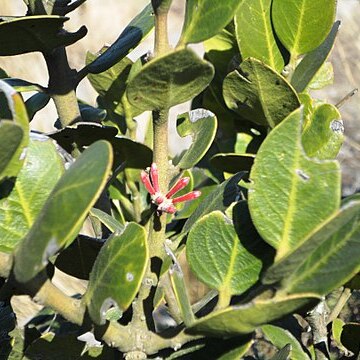A shrub or small tree. It can grow 5 m high. The bark is rough and grey to brown. The branches are angled. The plant has milky sap. The leaves are opposite and broadly oval. They are 8 cm long. They are shiny and dark green above and more pale underneath. They are stiff, rough on top and leathery. The flowers occur as many together in clusters in the axils of leaves. They have a sweet scent.
Corolla tube 9–12 mm. long, glabrous to minutely pubescent on external surface, long-pilose above and wrinkled below, on inner surface; corolla lobes subcircular with apex rounded or cuspidate, 3–5·5 mm. long, ciliate or not, pubescent or glabrous.
Small tree or shrub, up to 3 m high. Leaves broadly elliptic to subrotund, often strongly scabrid, obtuse to rounded at apex, secondary nerves rather indistinct. Fruit globose or subglobose. Flowers white or white tinged with pink.
Inflorescences dense contracted many-flowered axillary cymes; flowers sweet-smelling, with pink or red corolla tube and white lobes.
Stamens inserted at the top of the corolla tube so that the anther tips are just visible at anthesis; anthers 1–1·3 mm. long.
Calyx 2–2·5 mm. long, lobes ovate-acute with often slightly recurved tip, strongly imbricate, dorsally pubescent and ciliate.
Shrub or small much-branched tree up to 5 m. high and 5 m. in diameter, with rough bark.
Young branches pubescent or less often glabrous, conspicuously angled and ribbed.
Ripe fruit up to 2 cm. in diameter, subglobose, red to purple, 1–2-seeded.
Ovary 0·6–0·7 mm. long, conical.
Seeds up to 1 cm. long.


